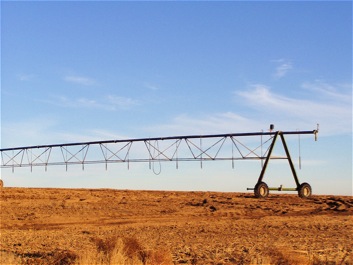Odessa Economics




ODESSA ECONOMICS
The Odessa Subarea encompasses 170,000 acres of irrigated farmland, where potatoes, peas and other water-dependent crops are grown. 121,000 of those acres fall within the original “second-half” boundaries of the Columbia Basin Project. The Odessa Subarea also comprises another several hundred thousand acres of dryland farms, primarily growing wheat. Although agricultural production has significant value both locally and to the Washington state economy, the actual value of crops grown in the Odessa Subarea is unknown.
Photos: Odessa potatoes are considered of high quality because they store well for later processing. French fries and potato chips are two major end products of Odessa potatoes.
The Washington Potato Commission paid for a 2005 WSU study to examine the value of of potatoes grown in the Odessa Subarea. The WSU study examined three scenarios, ranging from gradual loss of potato production in the Odessa to a “worst case” scenario in which all potato production in all four counties (both within the Odessa and in the Columbia Basin Project) ceases production simultaneously, without replacement.
Photo: Irrigated farming, Odessa Subarea.
Even the authors admit the worst case scenario is highly unlikely. They concluded that: “In the real world, the process of adjustment would involve the ability of the growers to grow potatoes in different regions of the Columbia basin or in other counties that would fit the needs of the processors. Also important would be the ability of the processors to adjust their production process to potato quality differences and still earn an acceptable return. Experience has shown growers have considerable ability to adapt to new situations by adjusting production methods, varieties grown, and location of production.”
The WSU study offers a range of conclusions. On one end, it concludes that the local economy would adjust to loss of Odessa potatoes and the regional economy would not be significantly disturbed.
The worst case scenario concludes that immediate loss of all potato production would result in an annual loss of $630 million. Irrigation advocates, including the Governor’s office and the U.S. Bureau of Reclamation are quick to cite the worst-case scenario, but do not provide context for its conclusions.
Photo: Dry-land wheat fields, eastern Washington.
What is never publicly discussed is the agronomic reality of growing potatoes. As noted in the Department of Ecology’s Nov. 2006 Water Supply Inventory (Appendix E), “Potatoes are different from many crops in that they cannot be grown for long in one location because of disease and pest problems. . . . The potato industry is beset by pest and disease problems that require crop rotation and eventual movement to new ground or yields will eventually decline.”
While there has been much discussion of the value of Odessa Subarea potato economics, there has been no analysis of the future of potato crop production in the Odessa Subarea.
Moreover, the Department of Ecology projects that there will be little new future demand for crop acreage. Again, the Nov. 2006 Water Supply Inventory (pp. 5-7/8) notes that “The expected trend in total crop acreage shows a stable pattern with no significant increase or decrease in acreage. . . . In terms of potential water demand, the lack of an increase in acreage and overall stability in crop patterns would suggest that, in aggregate, the demand for irrigation water should remain relatively constant with no significant new demand.”
Finally, there has been no public discussion comparing the projected economic impacts associated with loss of irrigated acreage in the Odessa Subarea with the cost of various solutions. Millions of public dollars will be spent on reports and appraisals before agencies get around to determining whether new water storage reservoirs are worth the price tag.




“ Experience has shown growers have considerable ability to adapt to new situations by adjusting production methods, varieties grown, and location of production.”
S. Bhattacharjee and D. Holland. The economic impact of a possible irrigation-water shortage in Odessa Sub-Basin: potato production and processing. WSU, 2005.